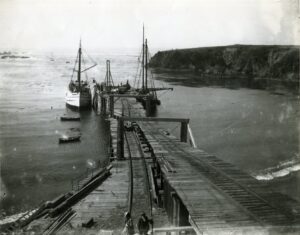Take a look at any panoramic photo of early Little River and you’ll notice that where once stood many structures – houses, the mill, hotels – there are now a lot of trees and bushes. Of the several vanished landmarks of long ago, there is one that wasn’t readily seen even when it existed: the shipyard of Thomas Petersen.

The Point Arena and Bessie Kimball moored at the Little River Wharf, circa 1910. This pile wharf replaced an earlier crib wharf in 1876, and was located in what is now the Van Damme State Park beach parking lot. Photo #2007-03-1334-23 may be purchased online here from Kelley House Museum.
A native of Denmark, his name remains on a little street at the top of the Highway 1 curve, just south of “The Inn At Cobbler’s Walk.” The shipyard was at the end of Petersen Lane, which is now a gated private property, and down on the shore below the rocky bluff.
Petersen built ships at several other places on our coast (more than any other shipwright), as well as in Washington state, but Little River was his favorite. It also had the most launchings – fourteen. Local folk always came out for the launchings, complete with a grand buffet in the carpentry shop. Since carpentry skills among locals were prevalent in those days, Petersen had good ship building help including, for a while, his brother John.
Petersen insisted on getting the best logs, three for each vessel – the mast, the keel and the body of the ship. The Albion area was the primary source for the trees. How the logs were transported to Little River is debatable, but from Little River beach they were floated at high tide and guided around the point.
Thomas’ Danish wife, Sophia, also assisted by weighing all the ironware parts – rivets, bolts and such – making sure the weight was balanced evenly on each side of the ship. The Petersens raised five children in their house on the bluff above the shipyard. They sold their home in 1887 and moved to Washington where Thomas died at age 79 in 1915.
Louis Hough authored a well-illustrated and definitive story of this remarkable man, “Thomas H. Petersen, Master Shipbuilder,” which was published in 2015 by Kelley House Museum and is sold there and on our Museum website.
Little River Bay was naturally one of the better harbors for shipping in the area; but having a few rock obstacles and no immunity to storms, it was not without a few wrecks. However, when heavy seas made Mendocino unsafe for unloading passengers and freight, they would come to Little River cove.
Coastal ports that shipped lumber products had two main methods for loading ships. The simplest was by “lighter,” a simple watercraft for the sole purpose of loading and unloading ships. Later came “apron chutes,” which were scaffold-like structures on the top of the bluffs extending out over the water with wires and cables to carry single boards or bundles of lumber or railroad ties to the ship. Later this was accomplished with wire cable systems that resembled giant “zip” lines. Little River had chutes at both the north and south sides of the harbor.
The first attempt to make a better port was a sort of haphazard floating pier-like construction that soon fell victim to tides and severe weather. Mill owners Silas Coombs and Ruel Stickney had a better idea. They applied for and were granted permission in 1872 to build a wharf and collect fees for its use.
The Little River Wharf extended from the cliff on the north side and extended 330 feet into the water. One of very few wharves in the area, and well-maintained, it lasted over forty years, which was quite an economic benefit to the mill as well as the town. Best reports estimate that it took four or so years to build.
It had two levels with rail tramways, the upper one for loading and unloading ties and freight, the lower one for lumber directly from the mill, which was located in what is now the entrance area to Van Damme State Park.
Getting people and goods in and out of the area by ship lasted a long time in this coastal area because there were few, and mostly awful, roads. Don’t even ask about bridges. Railroads were non-existent in early years. Eventually the train from Fort Bragg to Willits changed that and, with better roads, trucks did the freight hauling.
Although the exact date for the end of shipping from the Little River wharf is not known, the wharf was eventually abandoned. Two or three pilings could still be seen as late as 1923. A good photo of the wharf is hanging in the bar of the Little River Inn.
The Kelley House Museum is open Thursday through Sunday from 11am to 3pm. (707) 937-5791. Go to kelleyhousemuseum.org for more information or to book a historic walking tour.